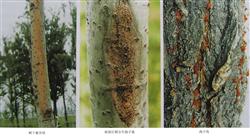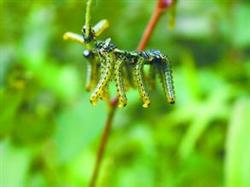Key points of cultivation techniques for fast-growing and high-yield poplar forest

In order to achieve fast growth, high yield, high quality and high efficiency of poplar, scientific cultivation techniques must be applied. According to the research results and practical experience of poplar cultivation techniques in our province, we should mainly master the following technical points: first, site selection. The selection of forest land suitable for poplar growth is the basic condition to realize the rapid growth and high yield of poplar. Poplar is a fast-growing species of deciduous broad-leaved trees, which grows best on alluvial soil with deep, loose, fertile, moist and well-drained soil. Poplar forest land in our province is mainly in plain area and river beach. Afforestation land should have the following conditions: 1. The soil layer is deep and the effective soil layer thickness is more than 1.0 meters. 2. The soil texture is lighter. The black poplar tree species (such as Populus tomentosa and American black poplar) are the best in light loam and sandy loam, followed by medium loam and tight sand, while poplar tree species (such as Populus tomentosa) can grow in lighter soil. 3. The groundwater level is suitable. The suitable groundwater level for poplar growth should be about 1.5 meters, and the groundwater level during the growing period should be less than 1 meter and not less than 2.5 meters. 4. The content of soil nutrients is high. Minimum requirements: organic matter content is more than 0.4%, nitrogen content is more than 0.03%. Available nitrogen is greater than 15mg/ liter, available phosphorus is greater than 2mg/ liter, and available potassium is greater than 40mg/ liter. 5. There is no saline-alkali or light saline-alkali in the soil. The salt content of soil should be less than 0.1%, and the salinity of groundwater should be less than 1 g / L. Second, meticulous ground preparation. After leveling the ground and repairing the drainage and irrigation ditch system, the afforestation land is ploughed (or turned deeply) above 30cm, and then a large hole is dug, with a diameter of 0.8 Mel 1.0 m and a depth of 0.8 mi 1 m. Third, select improved varieties and strong seedlings 1. Select improved varieties. The suitable fine varieties which have passed the provincial tree variety examination and approval are selected according to different cultivation objectives. (1) glued sheet. Plywood needs large diameter wood, straight shape, no scar, moderate wood hardness, good spin-cutting, drying and gluing properties. The main varieties suitable for cultivating glued plywood are the excellent varieties of black poplar school, such as Imur69, Imur72, L323, L324, Zhongmu 1, T26recoery T66, Zhonglin 46 poplar and so on. (2) Pulp wood requires poplar varieties to grow fast, light color, high wood density, high cellulose content, fiber length (should be more than 0.9mm), fiber length ratio more than 35, wall-lumen ratio less than 1, low impurity content and so on. Poplar varieties suitable for cultivating pulpwood are: Imur69 poplar, Imur72 poplar, L323 L324ter L35, Zhongli No. 1, Zhonglin 46, Irel 107, Zhonglin 23 and so on. (3) furniture materials. It is required that the trunk is straight and satisfactory, less scar knot, high wood density, fine structure, low heartwood content, high mechanical strength and hardness, easy drying, low swelling and shrinkage, easy processing, good adhesive paint performance and so on. The main varieties are Lumao 50, Yixian female plant, Imur69limi 107meme L35recoveri 102pr T26recoverT66, Zhonglin 23 poplar and so on. 2. Choose strong seedlings. The experiment shows that the afforestation of black poplar seedlings with 2-year-old roots and 2-year dry roots, with a height of more than 4.5 m and a DBH above 3.5cm, not only has a short slow seedling period and strong ability to resist natural disasters, but also has the advantages of fast growth, early maturity and high wood yield. The requirements for strong seedlings are developed and complete roots, sturdy seedlings, high Lignification of branches and shoots, full terminal buds, no mechanical damage, no diseases and insect pests. Fourth, planting density. The reasonable afforestation density should be determined according to the characteristics of poplar varieties, site conditions of afforestation site, cultivation target, cutting cycle and other factors. A woodland with good site conditions. For the varieties with fast growth and large crown, the density of large diameter wood is lower, and the site condition is poor. When the varieties with straight stem shape and narrow crown shape are selected, the density can be higher when cultivating stands with short rotation. According to the relevant provisions of the national wood standard on poplar, combined with the results of the study on the afforestation density of Shandong poplar high-yield forest, it is considered that the planting density of short-cycle pulp forest is 2 × 3 m, 3 × 3 m and 3 × 4 m. The planting density of glued wood is 5 × 6 m, 6 × 6 m and 4 × 8 m, in order to cultivate large diameter wood.
- Prev

Timely Control of Poplar Bacterial Canker and Rot
Poplar bacterial canker disease and poplar bark rot disease are mainly distributed in northeast, northwest and north China. They are common diseases in shelterbelt, timber forest and urban and rural greening poplar trees in northern China. Poplar bacterial canker disease and poplar bark rot disease are world-famous important diseases of poplar branches, but also common diseases. His biography...
- Next

Integrated control of poplar leaf-eating pests
Poplar is deeply loved by the people because of its fast-growing, wide growing area and outstanding economic benefits, but with the gradual expansion of poplar planting area, especially the development of pure forest area, the outbreak of poplar leaf-eating pests continues to occur, so the integrated control of poplar leaf-eating pests appears to be very.
Related
- Fuxing push coffee new agricultural production and marketing class: lack of small-scale processing plants
- Jujube rice field leisure farm deep ploughing Yilan for five years to create a space for organic food and play
- Nongyu Farm-A trial of organic papaya for brave women with advanced technology
- Four points for attention in the prevention and control of diseases and insect pests of edible fungi
- How to add nutrient solution to Edible Fungi
- Is there any good way to control edible fungus mites?
- Open Inoculation Technology of Edible Fungi
- Is there any clever way to use fertilizer for edible fungus in winter?
- What agents are used to kill the pathogens of edible fungi in the mushroom shed?
- Rapid drying of Edible Fungi

